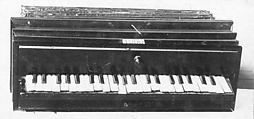Harmoniflûte
Not on view
The harmonilûte was created as an instrument that was between the small French accordion and the large harmonium free reed organ. The small keyboard instrument was typically set on a stand, and would often have a mechanism so that the player could pump with their feet. This example was probably pumped by hand. There is confusion about the invention of the instrument as both the Constant Busson and Mayer Marix workshops in Paris both claimed to have invented the instruments Busson presented it and won an award for his design at the Universal Exposition in Paris in 1855.
Technical description: An ebonized rectangular wood box (windchest), at the back of which (away from the player) a four-fold bellows with reservoir concealed below it in box; holes for air intake on backboard of bellows, protected by raised frame; at front of box a keyboard of small keys (bone naturals, ebony accidentals) controlling two rows of free reeds concealed within the box (naturals in one row, accidentals in the other); two brass free reeds side-by-side in one reed holder for each note; above the reeds, a row of brass tongues with pads at end, mounted on pivoted batten operated by hand stop, intended to damp one set of reeds; another hand stop for exhausting air from windchest; compass c-f3 (not tested); not furnished with stand or treadle, so evidently pumped by hand. (Laurence Libin 1978)
This image cannot be enlarged, viewed at full screen, or downloaded.

